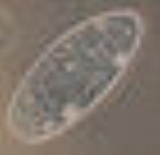
Paramecium
Overview
Paramecium is a group of unicellular ciliate
protozoa
, which are commonly studied as a representative of the ciliate group, and range from about 0.05 to 0.35 mm in length. Simple cilia cover the body, which allow the cell to move with a synchronous motion (like a caterpillar
) at speeds of approximately 12 body lengths per second. There is also a deep oral groove containing inconspicuous tongue-like compound oral cilia (as found in other peniculid
s) used to draw food inside.
Ciliate
The ciliates are a group of protozoans characterized by the presence of hair-like organelles called cilia, which are identical in structure to flagella but typically shorter and present in much larger numbers with a different undulating pattern than flagella...
protozoa
Protozoa
Protozoa are a diverse group of single-cells eukaryotic organisms, many of which are motile. Throughout history, protozoa have been defined as single-cell protists with animal-like behavior, e.g., movement...
, which are commonly studied as a representative of the ciliate group, and range from about 0.05 to 0.35 mm in length. Simple cilia cover the body, which allow the cell to move with a synchronous motion (like a caterpillar
Caterpillar
Caterpillars are the larval form of members of the order Lepidoptera . They are mostly herbivorous in food habit, although some species are insectivorous. Caterpillars are voracious feeders and many of them are considered to be pests in agriculture...
) at speeds of approximately 12 body lengths per second. There is also a deep oral groove containing inconspicuous tongue-like compound oral cilia (as found in other peniculid
Peniculid
The peniculids are an order of ciliate protozoa, including the well-known Paramecium and its close relatives. Most are relatively large, freshwater forms that feed on smaller organisms swept into the mouth. They have simple life cycles, and in many cases do not even form resting cysts.Typically...
s) used to draw food inside.
Unanswered Questions
Discussions

